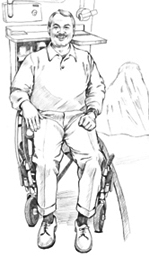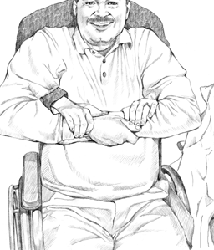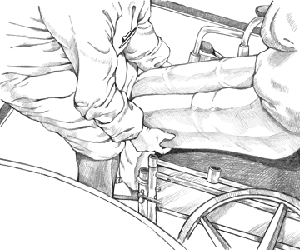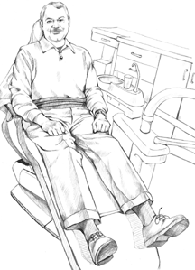printer-friendly PDF version  (1.27 MB)
(1.27 MB)
Some patients who use wheelchairs can transfer themselves into the dental chair, but others need assistance. The extent of your involvement will depend on the patient's or caregiver's ability to help. Most people can be transferred safely from wheelchair to dental chair and back by using the two-person method. The following outline describes a safe transfer with a minimum of apprehension for the patient and clinician. Practice these steps before doing an actual patient transfer.
Six Steps to A Safe Wheelchair Transfer
STEP 1: Determine the patient's needs
- Ask the patient or caregiver about
- preferred transfer method
- patient's ability to help
- use of special padding or a device for collecting urine
- probability of spasms
- Reduce the patient's anxiety by announcing each step of the transfer before it begins.
 Back to Top
Back to Top
STEP 2: Prepare the dental operatory
- Remove the dental chair armrest or move it out of the transfer area.
- Relocate the hoses, foot controls, operatory light, and bracket table from the transfer path.
- Position the dental chair at the same height as the wheelchair or slightly lower. Transferring to a lower level minimizes the amount of strength necessary during the lift.
 Back to Top
Back to Top
STEP 3: Prepare the wheelchair
 Remove the footrests.
Remove the footrests. - Position the wheelchair close to and parallel to the dental chair.
- Lock the wheels in place and turn the front casters forward.
- Remove the wheelchair armrest next to the dental chair.
- Check for any special padding or equipment.
 Back to Top
Back to Top
STEP 4: Perform the two-person transfer
- Support the patient while detaching the safety belt.
- Transfer any special padding or equipment from the wheelchair to the dental chair.
- First clinician: Stand behind the patient. Help the patient cross his arms across his chest. Place your arms under the patient's upper arms and grasp his wrists.
- Second clinician: Place both hands under the patient's lower thighs. Initiate and lead the lift at a prearranged count (1-2-3-lift).
- Both clinicians: Using your leg and arm muscles while bending your back as little as possible, gently lift the patient's torso and legs at the same time.
- Securely position the patient in the dental chair and replace the armrest.
THE TWO-PERSON TRANSFER |
|---|
 |  | First clinician stands behind the patient. | Second clinician initiates the lift. |
|
 Back to Top
Back to Top
STEP 5: Position the patient after the transfer 
- Center the patient in the dental chair.
- Reposition the special padding and safety belt as needed for the patient's comfort.
- If a urine-collecting device is used, straighten the tubing and place the bag below the level of the bladder.
 Back to Top
Back to Top
STEP 6: Transfer from the dental chair to the wheelchair
- Position the wheelchair close to and parallel to the dental chair.
- Lock the wheels in place, turn the casters forward, and remove the armrest.
- Raise the dental chair until it is slightly higher than the wheelchair and remove the armrest.
- Transfer any special padding.
- Transfer the patient using the two-person transfer (see step 4).
- Reposition the patient in the wheelchair.
- Attach the safety belt and check the tubing of the urine-collecting device, if there is one, and reposition the bag.
- Replace the armrest and footrests.
 Back to Top
Back to Top
This information can make a difference in your efforts to provide oral health care for patients who use a wheelchair. A skilled and sensitive dental staff can instill confidence during the transfer and encourage the patient to maintain a regular appointment schedule.
ACKNOWLEDGMENTS
The National Institute of Dental and Craniofacial Research thanks the oral health professionals and caregivers who contributed their time and expertise to reviewing and pretesting the Practical Oral Care series.
Expert Review Panel
Mae Chin, RDH, University of Washington, Seattle, WA
Sanford J. Fenton, DDS, University of Tennessee, Memphis, TN
Ray Lyons, DDS, New Mexico Department of Health, Los Lunas, NM
Christine Miller, RDH, University of the Pacific, San Francisco, CA
Steven P. Perlman, DDS, Special Olympics Special Smiles, Lynn, MA
David Tesini, DMD, Natick, MA
This booklet is one in a series on providing oral care for people with mild or moderate developmental disabilities. The issues and care strategies listed are intended to provide general guidance on how to complete a safe wheelchair transfer. Also available is a list of additional resources that links to other organizations that provide information on a variety of developmental disabilities topics.
Other booklets in this series:
For Health Professionals
For Caregivers
 Back to Top
Back to Top
 This information is not copyrighted. Print and make as many photocopies as you need.
This information is not copyrighted. Print and make as many photocopies as you need.
"Wheelchair Transfer: A Health Care Provider's Guide" is also available as a booklet. Order a free copy.
NIH Publication No. 07-5195
NOTE: PDF documents require the free Adobe Reader.